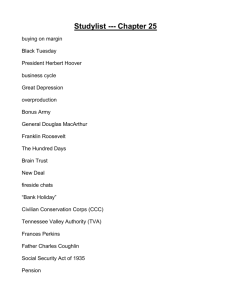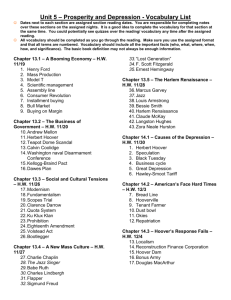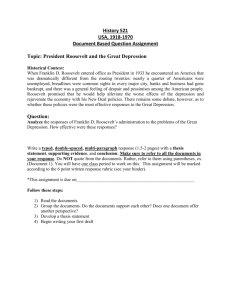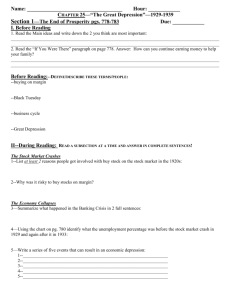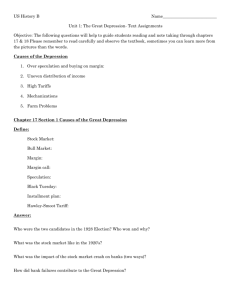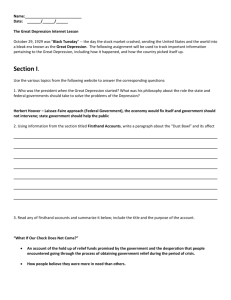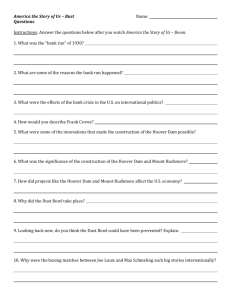Chapters 17 & 18 Test Review: Great Depression & New Deal
advertisement
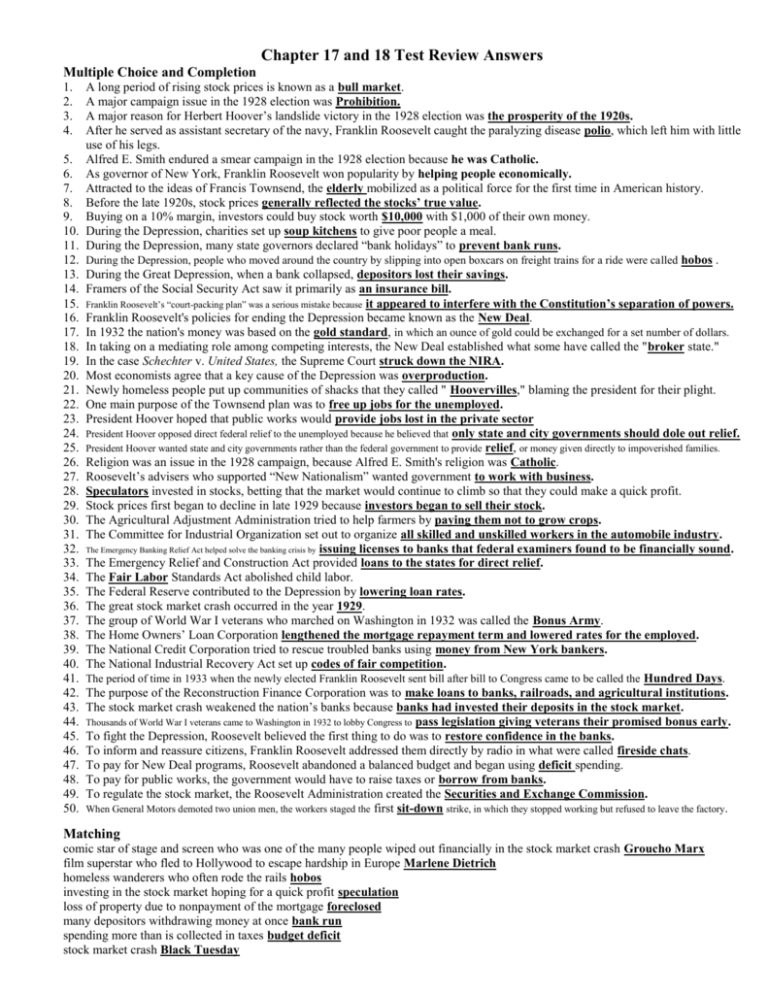
Chapter 17 and 18 Test Review Answers Multiple Choice and Completion 1. 2. 3. 4. 5. 6. 7. 8. 9. 10. 11. 12. 13. 14. 15. 16. 17. 18. 19. 20. 21. 22. 23. 24. 25. 26. 27. 28. 29. 30. 31. 32. 33. 34. 35. 36. 37. 38. 39. 40. 41. 42. 43. 44. 45. 46. 47. 48. 49. 50. A long period of rising stock prices is known as a bull market. A major campaign issue in the 1928 election was Prohibition. A major reason for Herbert Hoover’s landslide victory in the 1928 election was the prosperity of the 1920s. After he served as assistant secretary of the navy, Franklin Roosevelt caught the paralyzing disease polio, which left him with little use of his legs. Alfred E. Smith endured a smear campaign in the 1928 election because he was Catholic. As governor of New York, Franklin Roosevelt won popularity by helping people economically. Attracted to the ideas of Francis Townsend, the elderly mobilized as a political force for the first time in American history. Before the late 1920s, stock prices generally reflected the stocks’ true value. Buying on a 10% margin, investors could buy stock worth $10,000 with $1,000 of their own money. During the Depression, charities set up soup kitchens to give poor people a meal. During the Depression, many state governors declared “bank holidays” to prevent bank runs. During the Depression, people who moved around the country by slipping into open boxcars on freight trains for a ride were called hobos . During the Great Depression, when a bank collapsed, depositors lost their savings. Framers of the Social Security Act saw it primarily as an insurance bill. Franklin Roosevelt’s “court-packing plan” was a serious mistake because it appeared to interfere with the Constitution’s separation of powers. Franklin Roosevelt's policies for ending the Depression became known as the New Deal. In 1932 the nation's money was based on the gold standard, in which an ounce of gold could be exchanged for a set number of dollars. In taking on a mediating role among competing interests, the New Deal established what some have called the "broker state." In the case Schechter v. United States, the Supreme Court struck down the NIRA. Most economists agree that a key cause of the Depression was overproduction. Newly homeless people put up communities of shacks that they called " Hoovervilles," blaming the president for their plight. One main purpose of the Townsend plan was to free up jobs for the unemployed. President Hoover hoped that public works would provide jobs lost in the private sector President Hoover opposed direct federal relief to the unemployed because he believed that only state and city governments should dole out relief. President Hoover wanted state and city governments rather than the federal government to provide relief, or money given directly to impoverished families. Religion was an issue in the 1928 campaign, because Alfred E. Smith's religion was Catholic. Roosevelt’s advisers who supported “New Nationalism” wanted government to work with business. Speculators invested in stocks, betting that the market would continue to climb so that they could make a quick profit. Stock prices first began to decline in late 1929 because investors began to sell their stock. The Agricultural Adjustment Administration tried to help farmers by paying them not to grow crops. The Committee for Industrial Organization set out to organize all skilled and unskilled workers in the automobile industry. The Emergency Banking Relief Act helped solve the banking crisis by issuing licenses to banks that federal examiners found to be financially sound. The Emergency Relief and Construction Act provided loans to the states for direct relief. The Fair Labor Standards Act abolished child labor. The Federal Reserve contributed to the Depression by lowering loan rates. The great stock market crash occurred in the year 1929. The group of World War I veterans who marched on Washington in 1932 was called the Bonus Army. The Home Owners’ Loan Corporation lengthened the mortgage repayment term and lowered rates for the employed. The National Credit Corporation tried to rescue troubled banks using money from New York bankers. The National Industrial Recovery Act set up codes of fair competition. The period of time in 1933 when the newly elected Franklin Roosevelt sent bill after bill to Congress came to be called the Hundred Days. The purpose of the Reconstruction Finance Corporation was to make loans to banks, railroads, and agricultural institutions. The stock market crash weakened the nation’s banks because banks had invested their deposits in the stock market. Thousands of World War I veterans came to Washington in 1932 to lobby Congress to pass legislation giving veterans their promised bonus early. To fight the Depression, Roosevelt believed the first thing to do was to restore confidence in the banks. To inform and reassure citizens, Franklin Roosevelt addressed them directly by radio in what were called fireside chats. To pay for New Deal programs, Roosevelt abandoned a balanced budget and began using deficit spending. To pay for public works, the government would have to raise taxes or borrow from banks. To regulate the stock market, the Roosevelt Administration created the Securities and Exchange Commission. When General Motors demoted two union men, the workers staged the first sit-down strike, in which they stopped working but refused to leave the factory. Matching comic star of stage and screen who was one of the many people wiped out financially in the stock market crash Groucho Marx film superstar who fled to Hollywood to escape hardship in Europe Marlene Dietrich homeless wanderers who often rode the rails hobos investing in the stock market hoping for a quick profit speculation loss of property due to nonpayment of the mortgage foreclosed many depositors withdrawing money at once bank run spending more than is collected in taxes budget deficit stock market crash Black Tuesday successful engineer and former head of the Food Administration during World War I Herbert Hoover system for buying and selling shares of companies stock market True/False During the 1928 election campaign, Herbert Hoover promised to end Prohibition. False During the early 1930s, dust storms blackened the skies of the Great Plains for hundreds of miles. True Franklin Roosevelt came to office with a clear agenda for how he was going to deal with the Depression. False Herbert Hoover pushed Congress to provide federal government money for direct relief of impoverished families. False In response to the deepening Depression, Herbert Hoover massively increased government spending. False The Agricultural Adjustment Administration paid cotton farmers to plow under much of their crop. True The Farm Credit Administration helped many poor farmers keep their land, but it may have slowed the overall economic recovery. True The Hawley-Smoot Tariff dampened commerce on both sides of the Atlantic. True The Public Works Administration required its contractors to hire African Americans. True The Supreme Court declared the National Recovery Administration unconstitutional. True Essay 1. Use the example depicted in the diagram to explain how buying on margin works, and its risks and rewards. When buying stock on margin, investors made only a small cash down payment—as low as 10 percent of the price. With $1,000, an investor could buy $10,000 worth of stock. The other $9,000 would come as a loan from a stockbroker. If the stock price rose to, say, $12,000, the investor could sell it, pay off the $9,000 loan, and make a quick $2,000 profit on the $1,000 investment. However, if the stock price dropped to, say, $8,000, the broker might issue a margin call, demanding the investor repay the loan at once. In this case, the investor may not be able to repay the loan. After selling the stock and giving the broker the $8,000, the investor would still have to come up with $1,000 of his or her own money to pay off the $9,000 loan. Not only would the investor have lost his or her initial $1,000 investment, but with the additional $1,000 paid to the stockbroker, the investor’s total loss would be $2,000. 2. Discuss three major causes of the Great Depression. Most economists agree that overproduction was a key cause of the Depression. Increasingly efficient machinery greatly sped the production of factory and farm goods. Most Americans, however, did not earn enough to buy up the flood of goods they helped produce. As consumers bought more on the installment plan, the debt forced some to reduce their other purchases. As sales slowed, manufacturers cut production and laid off employees. Jobless workers had to cut back purchases even more, causing business activity to spiral downward. A second cause was the loss of export sales. American banks were making lucrative loans to speculators instead of to foreign companies. This fact, along with the Hawley-Smoot Tariff that dampened foreign sales in the United States, caused foreign countries to buy fewer American products. A third cause was mistakes by the Federal Reserve. Instead of raising interest rates to curb excessive speculation, it lowered rates. This action encouraged banks to make risky loans and encouraged businesses to borrow more money to expand production, adding to the problem of overproduction. 3. Use the diagram to help you explain how banks operate and why runs on banks can result in bank failure. Most banks make a profit by lending out money received from depositors and collecting interest on the loans. The bank holds only a fraction of the depositors’ money to cover everyday business, such as occasional withdrawals. Ordinarily that reserve is enough to meet the bank’s needs, but if too many people withdraw their money at the same time, the reserves will not be sufficient to cover the withdrawals, and the bank will eventually collapse. 4. Describe Herbert Hoover’s dilemma in considering whether to greatly increase public works projects to spur economic recovery. The problem was that someone had to pay for public works projects. If the government raised taxes to pay for them, it would take money away from consumers and hurt businesses that were already struggling. If the government decided to keep taxes low and run a budget deficit instead, it would have to borrow the money from banks. If the government did this, less money would be available for businesses that wanted to expand and for consumers who wanted mortgages or other loans. Hoover feared that deficit spending would actually delay an economic recovery. 5. Describe Franklin Roosevelt’s personality and approach to the nation’s problems. Americans saw in Roosevelt an energy and optimism that gave them hope despite the tough economic times. His serenity and confidence amazed many people, and his “fireside chats” helped reassure them. Also, many people believed that his struggle with polio had given him a better understanding of their hardships. Roosevelt’s confidence that he could make things better contrasted sharply with Hoover’s apparent failure to do anything effective. In his campaign for president, Roosevelt revealed the approach he would take as president: “Above all, try something.” He implemented his campaign promise with a flurry of bills to Congress during the first “Hundred Days.” Unlike the public impression of Hoover, Roosevelt was “doing something.” 6. Fill in the diagram about the Social Security system. Then write an essay describing how it initially worked, who benefited, and who did not. Source of funding: workers’ pay. Groups receiving benefits (order not important): (1) people with disabilities and poor families with young dependent children; (2) retirees (or the elderly); (3) unemployed workers looking for new jobs. Those left out: many farm and domestic workers. The framers of the Social Security Act viewed it primarily as an insurance bill, with workers earning the right to receive benefits by paying premiums. The law provided modest welfare payments to other needy people, including those with disabilities and poor families with young dependent children. The core of Social Security was the monthly retirement benefit, which people could collect when they stopped working at age 65. The plan also included unemployment insurance, providing temporary income to unemployed workers looking for new jobs. Social Security initially left out many of the neediest members of society—farm and domestic workers, many of whom were African American workers. 7. Describe the provisions of the National Labor Relations Act and the work of the board it created. The act guaranteed workers the right to organize unions without interference from employers and to bargain collectively. The law set up the National Labor Relations Board, which organized factory elections by secret ballot to determine whether workers wanted a union. The NLRB then certified the successful unions. The new law also set up a process whereby dissatisfied union members could take their complaints to binding arbitration, in which a neutral party would listen to both sides and decide the issues. The NLRB was authorized to investigate the actions of employers and could issue “cease and desist” orders against unfair practices. 8. Discuss the New Deal’s legacy, including its effectiveness in dealing with the Depression and its lasting effects on the role of government. The New Deal had only limited success in ending the Depression. Unemployment remained high, and economic recovery was not complete until after World War II. Even so, the New Deal gave many Americans a stronger sense of security and stability. The New Deal tended to operate so that it balanced competing economic interests. Business leaders, farmers, workers, consumers, homeowners, and others now looked to government to protect their interests. This “broker” role in mediating among competing interests has continued under the administrations of both parties ever since. Also, the New Deal programs created a “safety net” that protected people against economic disaster. After the Roosevelt years, the American people felt that the government had a duty to maintain this safety net, even though it required a larger, more expensive federal government.
